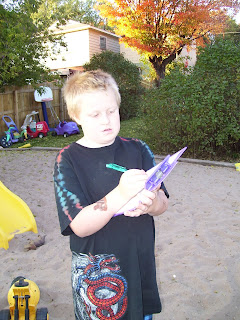While I was gone to the conference this past weekend, Allan and Dane built an "OGRE" catapult. (Well, their own version of one.) We have been trying all kinds of different experiences where Dane can either "blow things up" or send thing flying in the air. (Here is a link to one of our catapult projects)


This evening, we opted to try some predicting with the latest model of a catapult.
First, we tried to decide how far we thought the sponge bombs would fly. We wrote our predictions down.

 Then, it was time to....
Then, it was time to....Ready, Aim... Fire!
 After we shot all of the bombs, we used a measuring tape to determine how accurate our predictions were. We wrote down the actual distances and then compared them to the original guesses. Who was the closest? How much more/less did you guess? If you have to guess again, what would you say? Did the bombs all go the same distance? Why do you think that is? Do you think you can make the bombs land in the dump truck? Where do we have to put the dump truck? and the list of questions and investigations continued...
After we shot all of the bombs, we used a measuring tape to determine how accurate our predictions were. We wrote down the actual distances and then compared them to the original guesses. Who was the closest? How much more/less did you guess? If you have to guess again, what would you say? Did the bombs all go the same distance? Why do you think that is? Do you think you can make the bombs land in the dump truck? Where do we have to put the dump truck? and the list of questions and investigations continued...
 We repeated this process until the children decided that it was time to attempt another investigation... Is it possible to fill the slide with sand without having it all slide down?
We repeated this process until the children decided that it was time to attempt another investigation... Is it possible to fill the slide with sand without having it all slide down? They quickly discovered that it was easier to keep the sand on the slide if they poured it on very slowly.
They quickly discovered that it was easier to keep the sand on the slide if they poured it on very slowly. As it started to get dark and was time to go inside, they finished off their investigation by sliding down into the dirt.
As it started to get dark and was time to go inside, they finished off their investigation by sliding down into the dirt.On our way inside, I was asked: "Does a gorilla weigh more than a car?" I mentioned that we could look that information up either online or in a book, and of course, the response was no, "Can we really try it? " So now, does anyone have a huge scale, a gorilla, and a car we can borrow?????


Comments
I know that they modified the plans, but you will find some options for bigger catapults here.